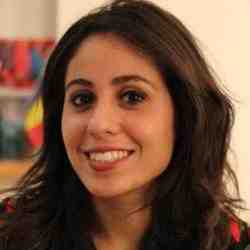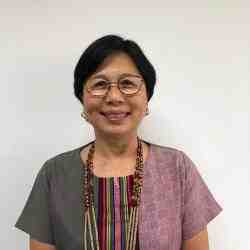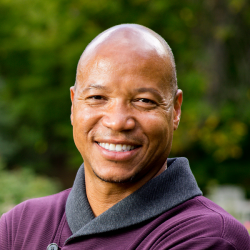Introduction
Molly Burhans is transforming the way the Catholic Church and other holders of large, non-contiguous lands are able to respond to climate change and its attendant crises, using new technology tools for informed environmental planning beyond the border of the nation-state.
The New Idea
Molly Burhans is transforming the way the Catholic Church is able to respond to the threats of climate change, environmental degradation, and the resulting impacts on human life, including mass human migration. Her organization, GoodLands, is building the first large-scale maps of the Catholic Church’s global landholdings using GIS (Geographic Information Systems) mapping. This enables them to aggregate vast amounts of data on these landholdings, which up until now have often been unused or underused, and facilitate informed decision-making on how best to utilize them to combat environmental issues.
She is bringing this technology, knowledge, and global perspective to a set of actors who have traditionally been local and low-tech. Working simultaneously at the global and local levels, she is leveraging canonical and municipal laws to take her model from “what’s possible” to “what’s likely.” She is also embarking on a campaign to familiarize stakeholders with the potential of the mapping and the model by using this technology to address non-climate issues flagged by the church, such as keeping schools open in California and promoting internet access in Uganda. The goal is to get the church engaged, and then to layer in new tools for stewarding its vast landholdings while building an understanding of climate change and its related issues as arenas for the Church to step up and take action using those landholdings and tools.
Molly envisions a future where the Catholic Church uses its landholdings to protect and enhance biodiversity and the environment, and where the Church, armed with knowledge provided by GIS mapping that predicts the path of climate migrants, uses its position as a global actor that transcends national borders to protect and care for people who must leave their homes in the face of climate change and food scarcity. She is working towards this future by educating the Church about what is possible and leveraging existing policies to make environmental conservation a more attractive prospect.
The Problem
With the threat of climate change and its attendant crises, including lost biodiversity, food insecurity and human migration, calling out for action, we need large-scale actors to commit to large-scale change to protect the environment and the people negatively impacted by climate disasters. These global challenges require global solutions that go beyond the borders of the nation-state. Animal habitats and biodiversity don’t conform to national borders, especially as the climate causes habitats to shift, and so preservation must work beyond borders. Food security is also a problem that requires global cooperation. Migration, which is on the rise as climate changes, is fundamentally a global issue, as migrants leave one nation and must find new homes in another. Despite the widespread nature of these challenges, most solutions are local, or at best national, which limits their efficacy, particularly in places where the effects of climate change are being felt first.
Given the limitations of the nation-state in rising to the global challenge of climate change, Molly believes we need to engage global, non-state actors. Unfortunately, the Catholic Church - which owns and stewards 177 million acres of land, an area larger than France or Spain, all over the globe - is ill-equipped to rise the the challenge. While the Church is a major presence globally in healthcare and education, they are much less involved in environmental conservation, despite a recent Papal encyclical calling for global action on climate change.
The Church, with its vast and global landholdings, is in a position to powerfully protect the environment and care for climate migrants, and solutions that utilize church-owned land have the potential to scale globally.The Church and its efforts to address climate change, however, are hampered by lack of knowledge of what they have and what they can do with it. It is too easy for land to be mismanaged and underutilized without a systemic approach and a robust knowledge of exactly what lands are church-owned, what they are currently being used for, and what is possible with them. This lack of knowledge puts the Church at financial risk as well. In the United States, if municipalities determine that Church land is not being used for its 501(c)3 mission, that land becomes taxable, which makes it unwise to leave land unused.
The Church’s total landholdings are increasing as individuals regularly bequest farmland and private property to the Church. Molly saw this firsthand while volunteering with a convent during college when, over a period of just 6 months, 2 large parcels of land were donated to the diocese. But given what she knows about the Church’s handling of land - to say nothing of its non-existent global inventory - she currently would never entrust the Church with land. But she believes that can, and must change. New knowledge and new models bring with them accountability and transparency that is currently absent, and ensure that land donated to the Church is used to further its global mission.
Other global actors like the British Commonwealth and the United Nations, who have jurisdiction over large non-contiguous land areas, also need to commit to change but struggle to marshall a comprehensive sense of their resources and challenges in order to plan effectively. They are interested in the model built by Molly and GoodLands as a potential way forward.
The Strategy
The Catholic Church remains a very low-tech actor. Despite the frequency with which dioceses perform real estate transactions, many often do not have digital spreadsheets documenting their properties as a whole. Molly’s work starts with making Church officials aware of both their global opportunity and their local risks. She communicates first the potential of the Church as a major player in the climate change fight, sharing her vision of the Church acting to preserve biodiversity, protect and care for migrants, and combat food insecurity. Then she raises awareness of the potential pitfalls of inactivity, including in the United States where she has mapped out areas where, as a result of leaving land unutilized, the Church is at risk for taxation if they don’t find ways to use their land to support their 501(c)3 mission. As municipalities switch to electronic tax systems, they often have much more knowledge about Catholic-owned land than the Church itself does, which puts the Church at financial risk that can be alleviated by embracing Molly’s model.
Many of the projects they have conducted to date have been used to demonstrate the potential of the mapping, such as by keeping schools open in California, promoting internet access in Uganda, and assisting with a project to help reunite children in orphanages with their families, issues flagged by Church communities but not necessarily key to Goodlands’ core climate change mission. This approach, however, meets the Church where they are and helps build familiarity with this kind of technology and its possibilities as Molly begins to educate Catholic decision-makers and communities about how this mapping can be used. Global maps of Church land and its environmental potential were displayed at the Vatican in 2016, communicating the possibility of using this mapping to reach beyond national borders. Projects like the mapping of Catholic orphanages also demonstrate this potential.
The orphanage-mapping project also puts Molly’s work in front of large numbers of Catholic nuns. Molly has identified the women religious as particularly powerful change agents within the church. Molly recognizes that if she can mobilize them for her mission of land use for social good, she can build a powerful movement. While she is building a new market for data and informed land use strategies with the Church as a chief client, Molly is simultaneously undergirding that market with a budding social movement of early adopters - like nuns - eager to move the church forward and willing to embrace new ways of thinking about land. The models and tools - not to mention Molly herself as a leader of a team-of-teams - are carried forward by powerful changemakers within the Church itself, including nuns.
At the Vatican, Molly works to apply leverage at the level of canonical law. In the wake of the Papal encyclical Laudato Si, which calls for protection of the environment, Molly has been able to secure audiences with influential Church authorities and represent GoodLands on the Vatican Arts and Technology Council, alongside Facebook, Google, and Twitter. In addition to highlighting the local leverage points of tax risk, she is working to expand how land is valued. The Church has existing rules prohibiting wasting or selling off land above a certain value, but these rules do not take into account the environmental opportunity cost of NOT doing something with this land, or its value to endangered species or biodiversity. Molly is advocating to modify the rules to take such concerns into consideration. She envisions the church as a future global leader in conservation, with an international system of parks and green spaces to preserve wildlife corridors and biodiversity.
Key to Molly’s work with Goodlands is GIS (Geographic Information Systems) mapping, which makes it possible to organize vast amounts of data and overlay it intelligibly over maps, allowing stakeholders to view detailed information about land, including current information and predictions about climate and the environment, population data and trends, and anything else that corresponds to geography. The ability to aggregate and communicate information using GIS represents a transformative tool for planning and prediction, which themselves are key tools in the fight against climate change. Other major multinational actors have taken an interest in Molly’s work and model as a method for land management and governance that does not rely on the nation-state. These include the British Commonwealth and the United Nations. Molly’s model reframes how people from any collective group are able to approach environmental policy and planning, with extensive knowledge to build on and share with stakeholders.
The Person
Molly was raised by a biologist and computer scientist. Some of her earliest memories are of backpacking with her parents through the wilderness in Vermont, California and Wyoming. Her parents taught her to deeply appreciate and respect nature. They also profoundly shaped how she seeks to understand nature through natural language, art, and computational exploration.
She began creating scientific figures and media for professional media when she was 14. During college she was involved in local arts, curated several art shows, ran events and co-founded her first company, Gro-Op. Gro-Op is a worker-owned cooperative vertical farming company that provides fresh produce and fish to Western New York. Over a decade of design work has helped her understand how to make accessible blueprints for complex ideas. She studied philosophy in undergraduate school, but also spent a significant amount of time reading and working through textbooks that covered various topics in science and mathematics.
During college, she volunteered at a convent, where she was considering becoming a nun. The properties owned by the sisters at this convent are spectacularly beautiful, but have issues with erosion, under-use, and growth of invasive species. She knew that their property management could be improved, and that this improvement would enhance all their ministries, as well as their financial stability. She decided to go to graduate school to help religious communities with land-use and landscape management. While studying ecological design, she had set her sights on joining the Vatican’s planning department or an equivalent of the Nature Conservancy in the Catholic NGO world. She discovered that there were no active Catholic NGOs helping the Church to conserve or steward its collectively massive landholdings - but she often encountered people at international conferences who remarked “The Church is the largest landholder in my country.” When the Pope’s environmental encyclical, Laudato Si’, was released, rich with discussions that related directly to sustainable development and land-use, she knew property management and land use within the Church had to be addressed by someone. Since no one else was, she founded GoodLands.
Molly worked with Esri, a prominent GIS software company, to build the first maps of Church-owned lands that she displayed at the Vatican in 2016. Seeing the potential of her model, they donated staff and resources. For five months, Molly managed a large, diverse staff that included the cartography team, prototype lab, systems architects, engineers, the video team, and the company composer. In December 2016 GoodLands was the only startup represented on the Vatican Arts and Technology Council alongside Google, Twitter, the MIT AI lab, and Facebook. They created a map gallery in the Vatican at Casina Pio IV, where Galileo had been the founding president of the Pontifical Academy of Sciences, and where individuals such as Niels Bohr, Einstein, and Stephen Hawking had gathered with their peers to share ideas. Molly says that being in spaces like these “...has given me hope that we can make the largest landholder in the world change its approach. It has also given me great inspiration and a profound understanding from my role models that no authentic change comes without great challenge, but I have been able to witness that it is possible.”

 Tile image
Tile image


